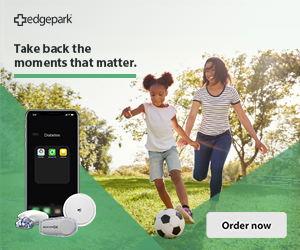3 key benefits of a CGM for athletes
If you're living with diabetes and are active in sports, a continuous glucose monitor (CGM) can be a great way to help you stay in the game. The devices are useful since they don't require fingersticks in everyday situations — but the benefits of a CGM are even more valuable when you consider how they can maximize your time on the court, the field, or anywhere else you channel your inner athlete. Here are a few sports-related reasons why a CGM can be considered a gamechanger if you're an active person living with diabetes.
Testing blood sugar levels during warm-up
With fingerstick blood glucose testing, there's a single reading that shows you what your blood sugar level is at that given moment in time. While it's useful information, it can also be limiting. With a CGM device, you get the added benefit of seeing trends in your blood sugar levels — that way, you're constantly aware of your blood sugar and whether it's stable, on the rise, or falling.
As a result, these trends can help you to keep your blood sugar on target.
Imagine you're about to play a game of basketball, and you do a fingerstick test beforehand. Your blood sugar is 130 milligrams per deciliter. Sounds good, right? However, what if your blood sugar is 130 milligrams per deciliter and falling fast? You wouldn't necessarily know that with a fingerstick, but a CGM has the ability to provide that information. Now that you know your blood sugar is on its way down — and that running on the basketball court is going to make it fall even faster — you can proactively grab a diabetes-friendly snack before you hit the court. As a result, you can avoid a potential low and time spent on the bench.
Water is no match for CGM
Have you ever tried to test your blood sugar levels after hopping out of the pool? If so, it's likely you already know how wet fingers and glucometer strips are a bad combination. Here's the good news: there are some CGMs available that come with transmitters and sensors that are waterproof or water-resistant.
If swimming is your sport of choice, with an applicable CGM device, you can easily hop out of the pool and check your blood sugar mid-swim — no fingerstick required. Once you get your blood glucose reading, you can take action if needed and then dive right back into the deep end.
Monitoring blood glucose levels at high altitudes
If you're living with diabetes and you enjoy winter sports such as skiing or snowboarding, you may already be aware that both increased altitude and cold temperatures may increase your need for insulin. You'll need to monitor your blood sugar more frequently than usual, but it's not necessarily easy to get a drop of blood out of an ice-cold fingertip. While you'll still most likely need to go to the ski lodge and remove your jacket to check your blood sugar with a CGM device, you'll be back on the slopes much faster and with more information to help you decide what to eat while you're there.
These are just three examples that show the benefits of a CGM for an athlete or someone who leads a more active lifestyle living with diabetes — but a CGM is useful in many other ways. For example, CGMs can alert you to highs and lows throughout the night, giving you a more peaceful night's rest than you may have had with fingerstick tests. CGM blood glucose testing can be easy, painless, and informative.
If you're interested in learning more about how you can benefit from CGM, read this article with questions to ask your doctor about using a CGM.




